The hot collar test on bushings may be performed on compound-type, porcelain dry-type bushing, oil-filled bushings, and cable potheads. The collar is energized by the test voltage (thus the term hot collar), while the center conductor is grounded.
It is well-established fact that the compound and dry type bushing fail from leaks that develop in the top end of the bushing allowing moisture to enter the bushing chamber. As a result, leakage paths are established which leads to bushing failure.
By applying a collar test in the upper region of the bushing, moisture, or deterioration can be detected in the early stages. The collar tests are also useful in detecting low levels of oil or compound in bushing and potheads.
The collar can be made of conductive rubber or metallic foil, braid, or wire. When performing collar tests, care should be used to ensure that the collar makes intimate contact with the surface of the bushing or pothead. Hot-collar tests may be made as single collar tests or multiple collar tests as shown in Figure.
Hot Collar Test on Bushings
A single hot-collar test consists of measurement between an externally applied collar and the bushing, while the center conductor is grounded (GST mode). In this test mode (Figure a), all currents passing between the energized collar and ground are measured.
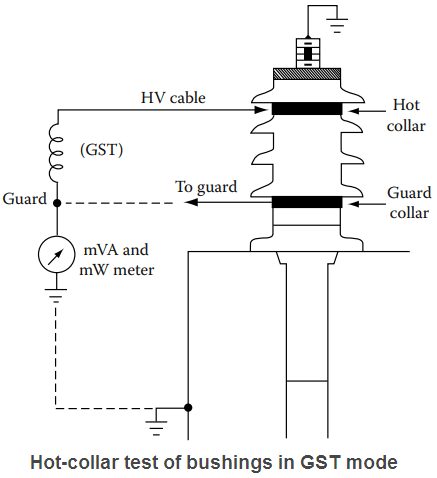
In the UST mode (Figure b), the current between the energized collar and the center conductor is measured including the surface leakage currents flowing over the upper portion of the bushing whereas the surface leakage currents flowing in the lower portion of the bushing (grounded flange mounting) are not measured.
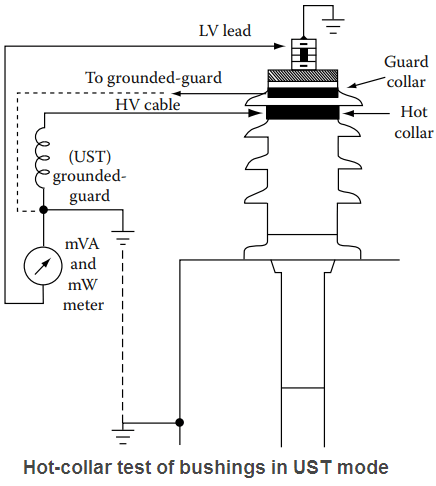
In the guard mode (Figure c), the currents between the energized collar and the center conductor are measured and the surface leakage currents flowing over the upper and lower portion of the bushing are guarded, whereas, in Figure d, the surface leakage current over the upper portion of the bushing only are guarded.
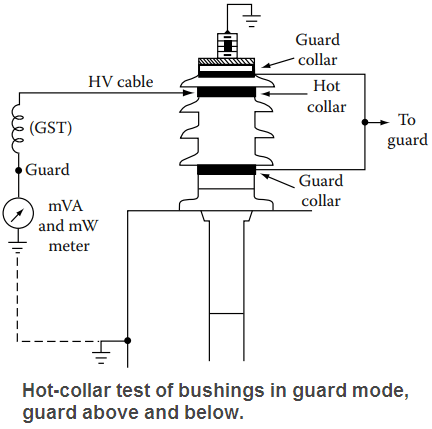
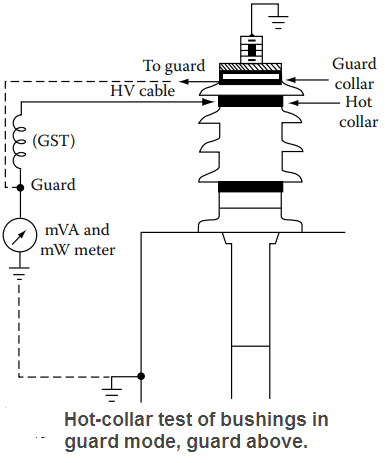
PF tests on Condenser Type Bushing
Transformer bushing may be classified into condenser and noncondenser type. The condenser-type bushing consists of oil-impregnated paper insulation or resin-bonded paper insulation with interspersed conducting (condenser) layers. The noncondenser-type bushing consists of solid core, alternate layers of solid and liquid insulation, homogeneous insulating materials, or gas-filled insulation.
The bushing may be further classified as having capacitance taps or PF taps. Bushing rated at 69 kV and above has capacitance taps whereas bushing 23 to 69 kV has PF test taps. A condenser-type bushing is usually used on transformers above 50 kV.
The condenser-type bushing is made up of equal capacitance layers (concentric capacitors) between the center conductor and ground flange. These concentric capacitors provide equal voltage steps; that is a uniform voltage gradient.
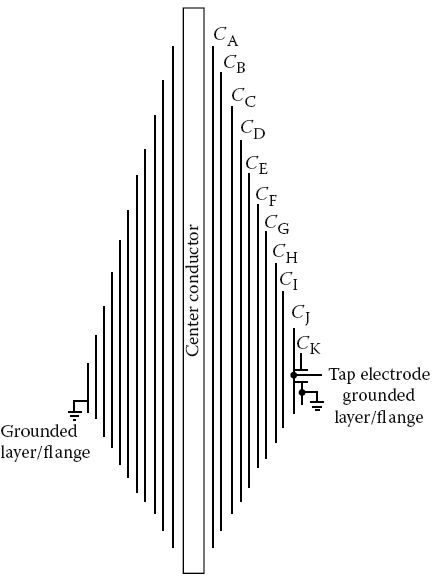
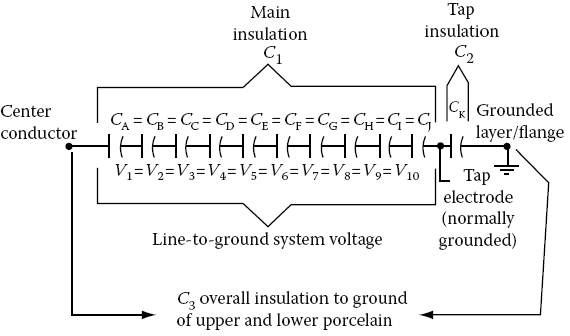
As shown in above Figure, the condenser-type bushing consists of 10 equal capacitance layers and each layer has a capacitance of 1 pico-farad (pf). Therefore the total capacitance (C) is equal to 0.1 pf.
For example, if one capacitance layer breaks down then the capacitance of the bushing would be one-ninth or 0.11 pf; or an increase in bushing capacitance of 0.01 pf, or a 10% increase. Above figure also shows the various insulations associated with the condenser-type bushing.
The main insulation C1 is the insulation from the conductor to the tap electrode or shield layer; the tap insulation C2 is between tap electrode and ground or flange, and C3 is the overall insulation to the ground of the upper and lower porcelain.
PF tests on bushing are usually performed by energizing the bushing conductor and measuring the test current and loss for the insulation system between the conductor and grounded flange.
Many modern bushings have capacitance taps or PF test taps. Test on bushings with taps can separately determine the core insulation (C1) from the tap insulation (C2). The various insulation systems of the bushing with taps are shown in following Figure.
The test connections for performing the PF test on bushing are given below. It should be noted that all bushings except the bushing under the test are shorted and grounded.
Test No. 1: This test measures the C1 insulation of the bushing.
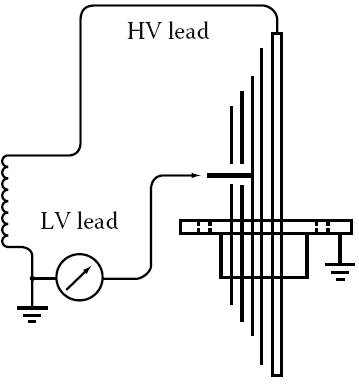
- Remove capacitance (or PF tap) tap cover from the bushing under test and make connections as shown in above figure.
- Put LV switch of PF test in UST mode.
- Measure charging current and watt loss.
- Calculate PF and capacitance; correct to 20°C.
- Compare results to manufacturers PF and capacitance on the nameplate.
- Capacitance should be ±10% of the nameplate and PF depends on the manufacturer (<1%).
Test No. 2: This test measures the C2 insulation of the bushing.
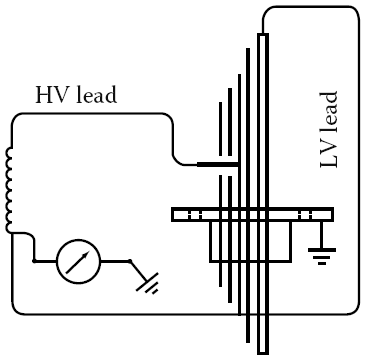
- Remove capacitance (or PF tap) tap cover from the bushing under test and make connections as shown in above figure.
- Put LV switch of PF test in guard mode.
- Guard C1 insulation as shown in the diagram.
- Measure charging current and watt loss.
- Calculate PF and capacitance; correct to 20°C.
- Compare results to manufacturer’s PF and capacitance on nameplate.
- Capacitance should be ±10% of the nameplate and PF depends on the manufacturer (<1%).
- Limit test voltages to 500 V for bushing less than 69 kV.
- Limit test voltages to 5000 V for bushing greater than 115 kV.
- Limit test voltages to 2000 V for Westinghouse “O”-plus bushing.
Test No. 3: This test measures the C1 and C2 insulation of the bushing (optional test).
- Remove capacitance (or PF tap) tap cover from the bushing under test and make connections of the HV lead as shown in above figure.
- Put LV switch of PF test in ground mode, i.e., C1 is not guarded out as was the case in Test No. 2, i.e., the low voltage lead is connected to ground side of the meter.
- Limit test voltages as shown in Test No. 2.
- This test measures C1 and C2, but C1 is very small compared to C2, therefore measures C2.
Test No. 4: This test measures the C3 insulation of the bushing (optional test).
- Remove capacitance (or PF tap) tap cover from the bushing under test and make connections as shown in Figure .
- Put LV switch of PF test in guard mode to guard out C2.
- Measure charging current and watt loss.
- Calculate PF and capacitance; correct to 20o
Test No. 5: This test measures the insulation of the bushing without capacitance or PF taps, or bushing not installed in equipment, i.e., spares.
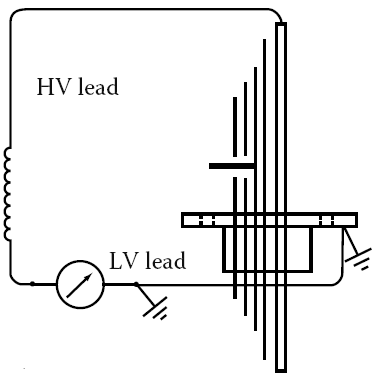
- Put LV switch of PF test in GST mode and make connections as shown in above Figure.
- Measure IT and watts loss; rate insulation on basis of watt loss.
- Limit should be less than 0.1 W.
Evaluation of Hot Collar Test on Bushings
PF tests, made regularly, have been used in assessing the serviceability of the bushing over the years. To decide whether a bushing should be removed from service because it has a slightly higher PF than normal depends upon the magnitude of the overall PF and hot-collar test results.
However, a bushing that shows a substantial increase in PF each year is an indication of a potential failure hazard. It is recommended that the bushing insulation should be evaluated based on the results of PF, capacitance, and hot-collar test results.
Concerning the hot-collar test, higher than normal losses are indicative of contamination or deterioration of bushing insulation. Any bushing differing significantly from others by a few milliwatts (up to one-tenth of a watt for the 10 kV test) should be investigated. The watts loss limit in the bushing for the 2.5 kV test is approximately 0.15 W.
The loss of oil or compound may be detected by comparing the hot-collar test current rather than the PF value. Abnormally low test current (10%–15%) may indicate an absence of compound or oil. Testing under successively lower petticoats (skirts) will show normal current reading when compound or oil is reached.
Modern oil-impregnated paper insulated condenser type bushings have PF of 0.5% or less at 20°C. Any such bushing which shows a significant increase should be investigated. Usually, the capacitance and/or PF value of a bushing are provided by the manufacture on the nameplate of the bushing which should be used for grading the PF and capacitance test results. Also, the previous year’s test results if available may be used in evaluating the field test results.
You may also read this PDF for more information on this topic.
Related Posts
- Transformer Oil Dielectric Strength Test
- How To Remove Moisture From Transformer Winding
- Power Factor Test of Transformer
- Dissolved Gas Analysis of Transformer Oil
- Online Monitoring of Transformers
- Hot Collar Test on Bushings
- Insulation Resistance Test of Transformer
© yourelectricalguide.com/ hot collar test on bushings.